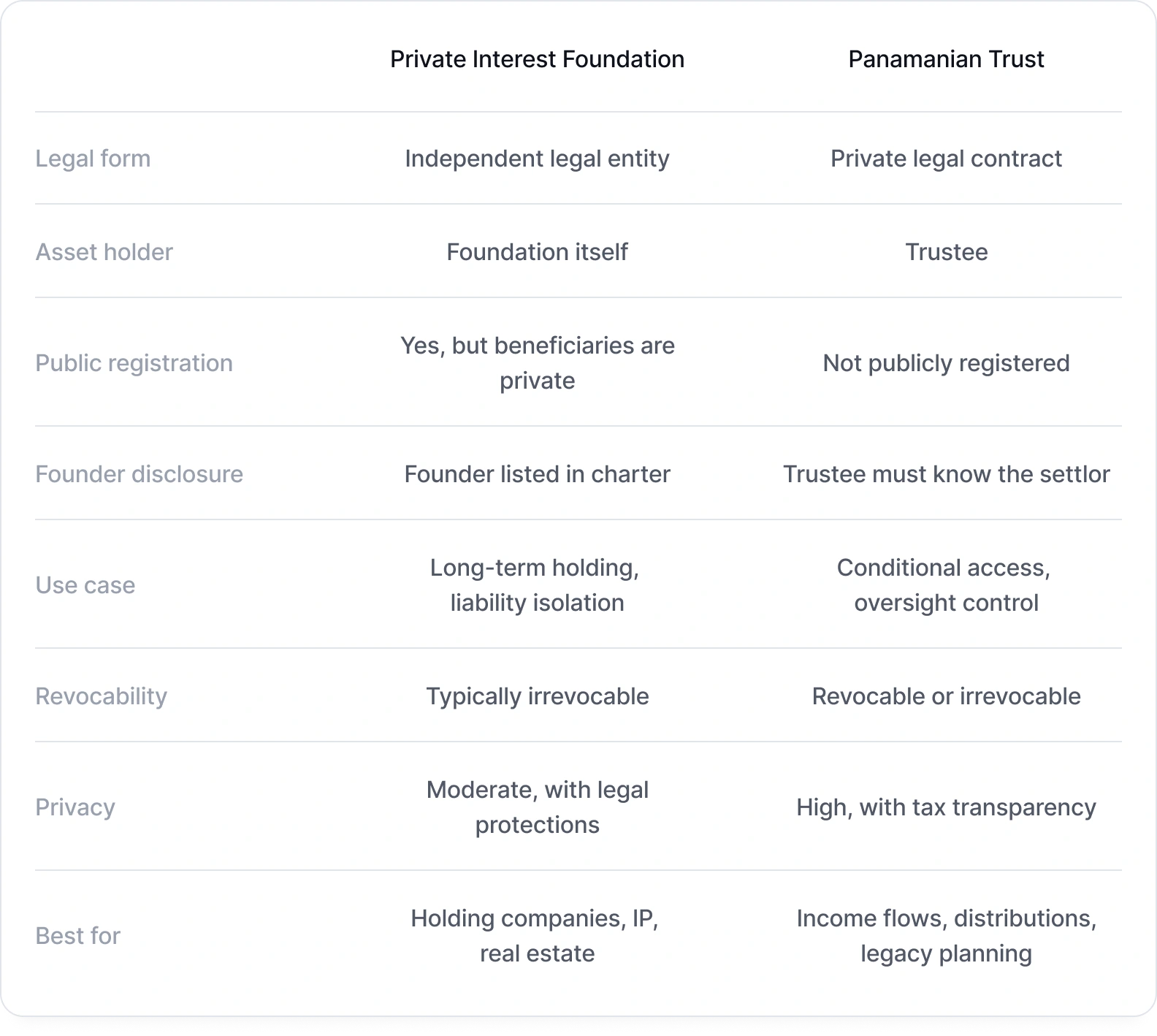
How Safe Is Panama Today for Asset Protection Structures?
This article explains how modern asset protection works in Panama today: what legal tools are used, how safe and private they are, and what’s changed in recent years due to global transparency rules. If you’re exploring international business options, here’s what you need to know.
TL;DR
- Panama remains relevant for international business structuring and asset protection.
- The key legal tools are Private Interest Foundations (PIFs) and Panamanian trusts.
- These help separate legal ownership from control, reduce liability, and streamline cross-border operations.
- While Panama no longer offers banking or ownership secrecy, it still allows for lawful privacy in asset holding and succession.
What Legal Tools Are Used in Panama Today
1. Private Interest Foundation (PIF)
A PIF is a standalone legal entity. It is commonly used by business owners and investors to protect and manage international assets.
Key features:
- Limiting liability. Assets held inside a PIF are legally separated from the founder’s personal or corporate liabilities. This is especially useful for people operating in high-risk industries or those exposed to frequent litigation.
- Central holding structure. A PIF can hold shares in operating companies, intellectual property, real estate, or investment accounts. It consolidates control across multiple jurisdictions in one neutral layer.
- Business continuity planning. Governance rules can be set inside the PIF to ensure smooth transfer of control in case of death, incapacity, or exit. This is a core advantage for entrepreneurs planning multi-generational business ownership.
2. Panamanian Trust
A trust is a private legal arrangement. It is typically used to manage how assets are accessed or distributed under certain conditions.
Key features:
- Control and oversight. Trusts allow you to set clear rules for access, such as waiting periods, voting conditions, or third-party approvals. This is often used in private equity, co-founder dynamics, or legacy planning.
- Global integration. Trusts can hold bank accounts, securities, or company shares across multiple jurisdictions. They are often used in tandem with structures from BVI, UAE, Luxembourg, or Switzerland.
- Discretion. Trusts are not registered in Panama’s public records. While full transparency must be provided to tax authorities, the legal structure remains private to the outside world.
- Tailored administration. The trust can include corporate trustees, protectors, or governance committees, allowing for precise and enforceable arrangements over time.
Trust vs Foundation: How They Compare

Why Panama Still Works for Business
Even with global compliance tightening, Panama continues to offer legal and structural benefits to international entrepreneurs and investors. Advantages include:
- Asset segregation. Founders and business owners can protect assets from legal exposure by placing them into a separate legal layer.
- Cross-border coordination. Panama structures are commonly used as neutral holding vehicles for managing global businesses across various tax and legal systems.
- Succession without probate. Unlike personal assets, those held in a PIF or trust bypass court inheritance processes. This saves time and avoids legal risk during transitions.
- Lower cost and flexibility. Compared to European or Asian structuring jurisdictions, Panama offers a more efficient and cost-effective path with similar legal protections.
What Changed in Recent Years
Panama is no longer a secrecy jurisdiction. It has adopted international transparency standards and eliminated legacy loopholes. Current compliance includes:
- Participation in the OECD Common Reporting Standard (CRS)
- Enforcement of FATF anti-money laundering requirements
- Mandatory beneficial ownership disclosures to local agents and regulators
Key restrictions now in place:
- No bearer shares or anonymous companies
- No banking secrecy
- Increased due diligence by global banks for Panama-linked structures
What Are the Risks
Using Panama the right way can offer real benefits. But missteps can lead to legal and reputational exposure. Common risks to avoid:
- Improper documentation. Vague or off-the-shelf structures may be challenged by tax authorities or civil courts.
- Poor coordination. Failure to align with your home country’s tax rules can trigger penalties or forced disclosures.
- Banking access issues. Some institutions apply extra scrutiny to Panama-based entities. A clear purpose and full documentation are essential.
- Substance requirements. Depending on your residence, local law may require your structure to demonstrate real activity or governance to avoid being disregarded.
Final Thoughts: Panama Is Still Effective When Used Correctly
For international founders, investors, and asset managers, Panama continues to offer solid legal tools for protection, control, and privacy. Private Interest Foundations and Panamanian trusts can form the backbone of your global structure if used with proper legal design, documentation, and purpose.
The old days of secrecy are gone. But for legitimate structures with strategic planning goals, Panama remains a valuable jurisdiction for asset protection and cross-border planning.












